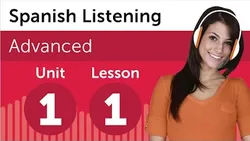
Basic Spanish 1: Getting Started 
This 7-week Spanish language course is designed to help students learn conversational Spanish from the basics. It covers the A1 proficiency level of the Common European Framework of Reference for Languages and includes activities to practice all four language skills. Students will be able to monitor their progress with performance tests and a final achievement test. ▼
ADVERTISEMENT
Course Feature
![]() Cost:
Cost:
Free
![]() Provider:
Provider:
ThaiMOOC
![]() Certificate:
Certificate:
Paid Certification
![]() Language:
Language:
English
![]() Start Date:
Start Date:
28th Mar, 2023
Course Overview
❗The content presented here is sourced directly from ThaiMOOC platform. For comprehensive course details, including enrollment information, simply click on the 'Go to class' link on our website.
Updated in [March 06th, 2023]
Basic Spanish 1: Getting Started is a 7-week course designed to help students learn conversational Spanish. The course covers the A1 proficiency level as described in the Common European Framework of Reference for Languages (CEFRL, Council of Europe 2001). Students will learn to introduce themselves, ask basic questions, and conduct brief conversations in Spanish.
The course includes activities to practice all four language skills: reading comprehension, writing, listening comprehension and speaking. Reference materials, cultural notes, grammar explanations, functions of language, etc. will be used to help students understand the language. Performance tests and a final achievement test will be used to monitor progress.
[Applications]
Upon completion of this course, students will be able to apply their knowledge of Spanish basics to everyday conversations. They will be able to introduce themselves, ask basic questions, and conduct a brief conversation in Spanish. Additionally, they will be able to understand and use basic grammar structures, as well as recognize and use common vocabulary. Students will also be able to identify and use cultural notes and functions of language.
[Career Paths]
1. Spanish Translator: Spanish translators are responsible for translating written documents from Spanish to English and vice versa. They must have a strong command of both languages and be able to accurately convey the meaning of the original text. Developing trends in this field include the use of machine translation and artificial intelligence to improve accuracy and speed of translation.
2. Spanish Teacher: Spanish teachers are responsible for teaching Spanish language and culture to students of all ages. They must have a strong command of the language and be able to effectively communicate with their students. Developing trends in this field include the use of technology to enhance the learning experience, such as virtual reality and online learning platforms.
3. Spanish Interpreter: Spanish interpreters are responsible for providing interpretation services between Spanish and English speakers. They must have a strong command of both languages and be able to accurately convey the meaning of the original text. Developing trends in this field include the use of remote interpreting technology to provide interpretation services to a wider audience.
4. Spanish Content Writer: Spanish content writers are responsible for creating content in Spanish for websites, blogs, and other digital media. They must have a strong command of the language and be able to effectively communicate with their audience. Developing trends in this field include the use of natural language processing and machine learning to create more accurate and engaging content.
[Education Paths]
1. Bachelor's Degree in Spanish: A Bachelor's Degree in Spanish is a great way to gain a comprehensive understanding of the language and its culture. This degree typically includes courses in Spanish literature, linguistics, and culture, as well as courses in Spanish grammar and conversation. Students will also have the opportunity to study abroad and gain real-world experience in a Spanish-speaking country. This degree is becoming increasingly popular as more people are looking to gain a competitive edge in the job market.
2. Master's Degree in Spanish: A Master's Degree in Spanish is a great way to further your knowledge of the language and its culture. This degree typically includes courses in Spanish literature, linguistics, and culture, as well as courses in Spanish grammar and conversation. Students will also have the opportunity to study abroad and gain real-world experience in a Spanish-speaking country. This degree is becoming increasingly popular as more people are looking to gain a competitive edge in the job market.
3. Doctorate Degree in Spanish: A Doctorate Degree in Spanish is the highest level of education available in the language. This degree typically includes courses in Spanish literature, linguistics, and culture, as well as courses in Spanish grammar and conversation. Students will also have the opportunity to study abroad and gain real-world experience in a Spanish-speaking country. This degree is becoming increasingly popular as more people are looking to gain a competitive edge in the job market.
4. Certificate in Spanish: A Certificate in Spanish is a great way to gain a basic understanding of the language and its culture. This certificate typically includes courses in Spanish grammar and conversation, as well as cultural notes and functions of language. Students will also have the opportunity to gain real-world experience in a Spanish-speaking country. This certificate is becoming increasingly popular as more people are looking to gain a competitive edge in the job market.
Course Provider

Provider ThaiMOOC's Stats at AZClass
Discussion and Reviews
0.0 (Based on 0 reviews)
Explore Similar Online Courses

Rapid Gameplay Prototyping

Simple Recurrent Neural Network with Keras

Python for Informatics: Exploring Information

Social Network Analysis

Introduction to Systematic Review and Meta-Analysis

The Analytics Edge

DCO042 - Python For Informatics

Causal Diagrams: Draw Your Assumptions Before Your Conclusions

Whole genome sequencing of bacterial genomes - tools and applications

Spanish tutorials & lessons for beginners

Spanish Listening Comprehension for Advanced Learners

Learn Basic Mexican Spanish
 Related Categories
Related Categories
Quiz
 Submitted Sucessfully
Submitted Sucessfully
1. What is the purpose of this course?
2. What language proficiency level will be achieved after completing this course?
3. What are the four language skills that will be practiced in this course?
4. What is the main goal of this course?
5. What is the Common European Framework of Reference for Languages (CEFRL)?
Correct Answer: It is a framework created by the Council of Europe in 2001.


Start your review of Basic Spanish 1: Getting Started